
Ealdred was Abbot of Tavistock, Bishop of Worcester, and Archbishop of York in early medieval England. He was related to a number of other ecclesiastics of the period. After becoming a monk at the monastery at Winchester, he was appointed Abbot of Tavistock Abbey in around 1027. In 1046 he was named to the Bishopric of Worcester. Ealdred, besides his episcopal duties, served Edward the Confessor, the King of England, as a diplomat and as a military leader. He worked to bring one of the king's relatives, Edward the Exile, back to England from Hungary to secure an heir for the childless king.

Lindisfarne, also called Holy Island, is a tidal island off the northeast coast of England, which constitutes the civil parish of Holy Island in Northumberland. Holy Island has a recorded history from the 6th century AD; it was an important centre of Celtic Christianity under Saints Aidan, Cuthbert, Eadfrith, and Eadberht of Lindisfarne. The island was originally home to a monastery, which was destroyed during the Viking invasions but re-established as a priory following the Norman Conquest of England. Other notable sites built on the island are St Mary the Virgin parish church, Lindisfarne Castle, several lighthouses and other navigational markers, and a complex network of lime kilns. In the present day, the island is an Area of Outstanding Natural Beauty and a hotspot for historical tourism and bird watching. As of February 2020, the island had three pubs, a hotel and a post office.

Eric Haraldsson, nicknamed Bloodaxe and Brother-Slayer, was a Norwegian king. He ruled as King of Norway from 932 to 934, and twice as King of Northumbria: from 947 to 948, and again from 952 to 954.
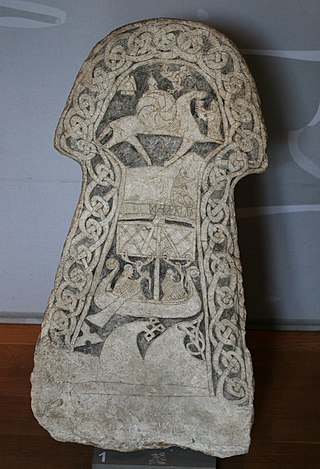
In Norse mythology, a valkyrie is one of a host of female figures who guide souls of the dead to the god Odin's hall Valhalla. There, the deceased warriors become einherjar. When the einherjar are not preparing for the cataclysmic events of Ragnarök, the valkyries bear them mead. Valkyries also appear as lovers of heroes and other mortals, where they are sometimes described as the daughters of royalty, sometimes accompanied by ravens and sometimes connected to swans or horses.

In Germanic heroic legend and folklore, Fáfnir is a worm or dragon slain by a member of the Völsung family, typically Sigurð. In Nordic mythology, he is the son of Hreiðmarr, and brother of Regin and Ótr and is attested throughout the Völsung Cycle, where, Fáfnir slays his father out of greed, taking the ring and hoard of the dwarf Andvari and becoming a worm or dragon. Fáfnir's brother Regin later assisted Sigurð in obtaining the sword Gram, by which Fáfnir is killed. He has been identified with an unnamed dragon killed by a Völsung in other Germanic works including Beowulf, the Nibelunglied and a number of skaldic poems. Fáfnir and his killing by Sigurð are further represented in numerous medieval carvings from the British Isles and Scandinavia, and a single axe head in a Scandinavian style found in Russia. The story of Fáfnir has continued to have influence in the modern period, such as in the works of J.R.R Tolkien, who drew inspiration from the tale of Fáfnir in his portrayals of Smaug and Gollum.
Túrin Turambar is a fictional character in J. R. R. Tolkien's legendarium. Turambar and the Foalókë, begun in 1917, is the first appearance of Túrin in the legendarium. Túrin is a Man of the First Age of Middle-earth, whose family had been cursed by the Dark Lord Morgoth. While trying vainly to defy the curse, Túrin brings ruin across much of Beleriand, and upon himself and his sister Niënor. His title, "Turambar", means master of fate.

The Anglo-Normans were the medieval ruling class in England following the Norman Conquest, and were primarily a combination of Normans, Frenchmen, Flemings, and Bretons who intermarried with the indigenous Anglo-Saxons and Celtic Britons. A small number of Normans had earlier befriended future Anglo-Saxon king of England, Edward the Confessor, during his exile in his mother's homeland of Normandy in northern France. When he returned to England, some of them went with him; as such, there were Normans already settled in England prior to the conquest. Edward's successor, Harold Godwinson, was defeated by Duke William the Conqueror of Normandy at the Battle of Hastings, leading to William's accession to the English throne.
Solomon and Saturn is the generic name given to four Old English works, which present a dialogue of riddles between Solomon, the king of Israel, and Saturn, identified in two of the poems as a prince of the Chaldeans.

TheDream of the Rood is one of the Christian poems in the corpus of Old English literature and an example of the genre of dream poetry. Like most Old English poetry, it is written in alliterative verse. Rood is from the Old English word rōd 'pole', or more specifically 'crucifix'. Preserved in the 10th-century Vercelli Book, the poem may be as old as the 8th-century Ruthwell Cross, and is considered one of the oldest works of Old English literature.
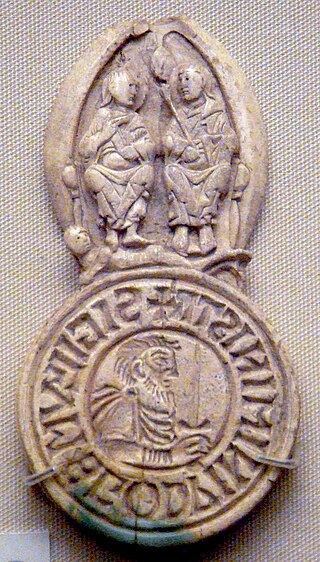
In later Anglo-Saxon England, a thegn or thane was an aristocrat who owned substantial land in one or more counties. Thanes ranked at the third level in lay society, below the king and ealdormen. Thanage refers to the tenure by which lands were held by a thane as well as the rank.
"The Wife's Lament" or "The Wife's Complaint" is an Old English poem of 53 lines found on folio 115 of the Exeter Book and generally treated as an elegy in the manner of the German frauenlied, or "women's song". The poem has been relatively well preserved and requires few if any emendations to enable an initial reading. Thematically, the poem is primarily concerned with the evocation of the grief of the female speaker and with the representation of her state of despair. The tribulations she suffers leading to her state of lamentation, however, are cryptically described and have been subject to many interpretations. Indeed, Professor Stephen Ramsay has said, "the 'correct' interpretation of "The Wife's Lament" is one of the more hotly debated subjects in medieval studies."

Anglo-Saxon art covers art produced within the Anglo-Saxon period of English history, beginning with the Migration period style that the Anglo-Saxons brought with them from the continent in the 5th century, and ending in 1066 with the Norman Conquest of England, whose sophisticated art was influential in much of northern Europe. The two periods of outstanding achievement were the 7th and 8th centuries, with the metalwork and jewellery from Sutton Hoo and a series of magnificent illuminated manuscripts, and the final period after about 950, when there was a revival of English culture after the end of the Viking invasions. By the time of the Conquest the move to the Romanesque style is nearly complete. The important artistic centres, in so far as these can be established, were concentrated in the extremities of England, in Northumbria, especially in the early period, and Wessex and Kent near the south coast.
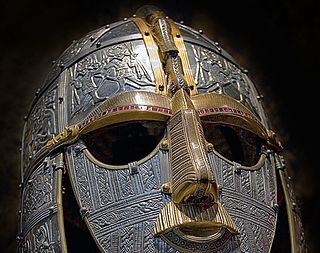
Anglo-Saxon paganism, sometimes termed Anglo-Saxon heathenism, Anglo-Saxon pre-Christian religion, Anglo-Saxon traditional religion, or Anglo-Saxon polytheism refers to the religious beliefs and practices followed by the Anglo-Saxons between the 5th and 8th centuries AD, during the initial period of Early Medieval England. A variant of Germanic paganism found across much of north-western Europe, it encompassed a heterogeneous variety of beliefs and cultic practices, with much regional variation.

The Battle of Ashdown was a West Saxon victory over a Danish Viking army on about 8 January 871. The location of Ashdown is not known, but may be Kingstanding Hill in Berkshire. Other writers place the battle near Starveall, a short distance north of the village of Aldworth and south east of Lowbury Hill.
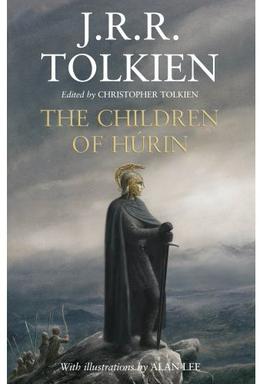
The Children of Húrin is an epic fantasy novel which forms the completion of a tale by J. R. R. Tolkien. He wrote the original version of the story in the late 1910s, revising it several times later, but did not complete it before his death in 1973. His son, Christopher Tolkien, edited the manuscripts to form a consistent narrative, and published it in 2007 as an independent work. The book is illustrated by Alan Lee. The story is one of three "Great Tales" set in the First Age of Tolkien's Middle-earth, the other two being Beren and Lúthien and The Fall of Gondolin.
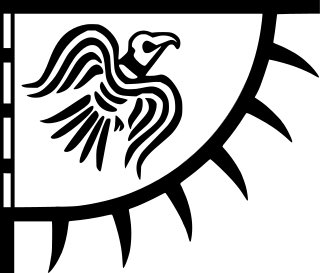
The raven banner was a flag, possibly totemic in nature, flown by various Viking chieftains and other Scandinavian rulers during the 9th, 10th and 11th centuries. Period description simply describes it as a war banner with a raven mark on it, although no complete visual description or depiction of the raven banner is known from the time. Norse and European period artwork, however, depicts war banners as roughly triangular, with a rounded outside edge on which there hung a series of tabs or tassels, some with a resemblance to ornately carved "weather-vanes" used aboard Viking longships, indicating that some raven banners may have been constructed in a similar manner.

Daniel is an anonymous Old English poem based loosely on the Biblical Book of Daniel, found in the Junius Manuscript. The author and the date of Daniel are unknown. Critics have argued that Cædmon is the author of the poem, but this theory has been since disproven. Daniel, as it is preserved, is 764 lines long. There have been numerous arguments that there was originally more to this poem than survives today. The majority of scholars, however, dismiss these arguments with the evidence that the text finishes at the bottom of a page, and that there is a simple point, which translators assume indicates the end of a complete sentence. Daniel contains a plethora of lines which Old English scholars refer to as “hypermetric” or long.
Magic in Anglo-Saxon England refers to the belief and practice of magic by the Anglo-Saxons between the fifth and eleventh centuries AD in Early Mediaeval England. In this period, magical practices were used for a variety of reasons, but from the available evidence it appears that they were predominantly used for healing ailments and creating amulets, although it is apparent that at times they were also used to curse.
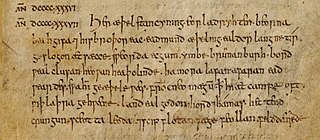
The "Battle of Brunanburh" is an Old English poem. It is preserved in the Anglo-Saxon Chronicle, a historical record of events in Anglo-Saxon England which was kept from the late ninth to the mid-twelfth century. The poem records the Battle of Brunanburh, a battle fought in 937 between an English army and a combined army of Scots, Vikings, and Britons. The battle resulted in an English victory, celebrated by the poem in style and language like that of traditional Old English battle poetry. The poem is notable because of those traditional elements and has been praised for its authentic tone, but it is also remarkable for its fiercely nationalistic tone, which documents the development of a unified England ruled by the House of Wessex.
Durham, also known as De situ Dunelmi, Carmen de situ Dunelmi or De situ Dunelmi et de sanctorum reliquiis quae ibidem continentur carmen compositum, is an anonymous late Old English short poem about the English city of Durham and its relics, which might commemorate the translation of Cuthbert's relics to Durham Cathedral in 1104. Known from the late 12th-century manuscript, Cambridge, University Library, Ff. 1. 27, Durham has been described both as "the last extant poem written in traditional alliterative Old English metrical verse" and as being placed "so conveniently on the customary divide between Old and Middle English that the line can be drawn right down the middle of the poem." Scholars have dated the poem either to the twelfth century or to some point in the second half of the eleventh century.















